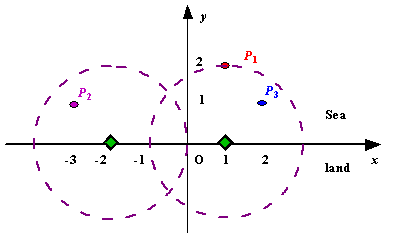Radar Installation
| Time Limit: 1000MS | Memory Limit: 10000K | |
| Total Submissions: 60327 | Accepted: 13597 |
Description
Assume the coasting is an infinite straight line. Land is in one side of coasting, sea in the other. Each small island is a point locating in the sea side. And any radar installation, locating on the coasting, can only cover d
distance, so an island in the sea can be covered by a radius installation, if the distance between them is at most d.
We use Cartesian coordinate system, defining the coasting is the x-axis. The sea side is above x-axis, and the land side below. Given the position of each island in the sea, and given the distance of the coverage of the radar installation, your task is to write a program to find the minimal number of radar installations to cover all the islands. Note that the position of an island is represented by its x-y coordinates.

Figure A Sample Input of Radar Installations
We use Cartesian coordinate system, defining the coasting is the x-axis. The sea side is above x-axis, and the land side below. Given the position of each island in the sea, and given the distance of the coverage of the radar installation, your task is to write a program to find the minimal number of radar installations to cover all the islands. Note that the position of an island is represented by its x-y coordinates.

Figure A Sample Input of Radar Installations
Input
The input consists of several test cases. The first line of each case contains two integers n (1<=n<=1000) and d, where n is the number of islands in the sea and d is the distance of coverage of the radar installation. This is
followed by n lines each containing two integers representing the coordinate of the position of each island. Then a blank line follows to separate the cases.
The input is terminated by a line containing pair of zeros
The input is terminated by a line containing pair of zeros
Output
For each test case output one line consisting of the test case number followed by the minimal number of radar installations needed. "-1" installation means no solution for that case.
Sample Input
3 2 1 2 -3 1 2 1 1 2 0 2 0 0
Sample Output
Case 1: 2 Case 2: 1#include <iostream> #include <cstring> #include <cstdio> #include <cmath> #include <algorithm> using namespace std; struct node { double l,r; } ls[1010]; bool cmp(node a,node b) { return a.l < b.l; } int main() { //freopen("in.txt","r",stdin); std::ios::sync_with_stdio(false); int n; double r; int t = 0; while(cin>>n>>r && (n || r)) { bool flag = true; for(int i=0; i<n; i++) { double a,b; cin>>a>>b; if(fabs(b) > r) flag = false; else { ls[i].l = a - sqrt(r*r - b*b); ls[i].r = a + sqrt(r*r - b*b); } } cout<<"Case "<<++t<<": "; if(!flag) cout<<-1<<endl; else { int ant = 0; sort(ls,ls+n,cmp); node up = ls[0]; for(int i=1; i<n; i++) { if(ls[i].l > up.r) { up = ls[i]; ant++; } else if(ls[i].r < up.r) { up = ls[i]; } } cout<<ant+1<<endl; } } return 0; }





















 737
737

 被折叠的 条评论
为什么被折叠?
被折叠的 条评论
为什么被折叠?








